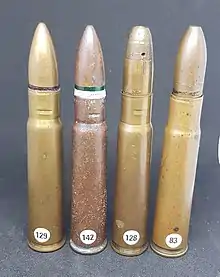Ho-103 machine gun
The 12.7mm Type 1 (1941) was a Japanese aircraft machine gun widely used during World War II and also known as the Ho-103.[2] It was based on the American .50-caliber M1921 aircraft Browning machine gun.[1]
| Ho-103 machine gun | |
|---|---|
 12.7 mm Ho-103 machine gun on display at the Steven F. Udvar-Hazy Center | |
| Type | Machine gun |
| Place of origin | |
| Service history | |
| Used by | Imperial Japanese Army |
| Wars | World War II |
| Production history | |
| Produced | 1941 to 1945 |
| Specifications | |
| Mass | 23 kilograms (50.7 lb) |
| Length | 1,267 mm (49.9 in) |
| Barrel length | 800 mm (31 in) |
| Cartridge | 12.7×81mmSR Breda[1] |
| Action | Recoil operation |
| Rate of fire | 900 RPM 400 RPM (synchronized) |
| Muzzle velocity | 770 m/s (2,500 ft/s) |
| Feed system | Belt 250 rounds |
| Sights | Iron |
The Ho-103 achieved a higher rate of fire by using a smaller, lower velocity Breda (Vickers) cartridge, intermediate in length between the WWII German 13 mm calibre MG 131's 64mm length cartridge, and the long 99mm cartridge of the veteran American M2 Browning .50 calibre gun. Because of this, the gun was frequently loaded with explosive or incendiary ammunition in an attempt to increase its effectiveness.
Types of ammunition used by this gun are:
- Ball, marked with a pink/red seal around the casemouth.
- Two types of Armour Piercing Tracer, marked with a black (red tracer) or green and white (white tracer) seal around the casemouth.
- Ma 102 Fuseless Explosive Incendiary, marked with a dark purple seal around the casemouth.
- Ma 103 Fuzed Explosive Incendiary, marked with a clear (single piece fuze) or white (2-piece fuze) seal around the casemouth.[3]

Variants
The Type 1 was produced in two variants. The Ho-103 was used in fixed installations, while the Ho-104 was used in flexible installations.[1]
Design
The 12.7×81mmSR allowed the Type 1 to fire at a rate of 900 RPM, but the poor suitability of the Browning action to synchronization reduced the rate of fire to 400 RPM in synchronized installations.[1] However, the Japanese source and Allied Intelligence reports[4] did not mention that this machine gun had a propeller synchronization flaw. The source for the Bell P-63 Kingcobra also doesn't mention the propeller synchronization flaw in the browning design.
References
- Rottman, Page 22.
- http://www.dragonsoffire.com/aircraft-jarmy.htm
- Japanese Ammunition 1880-1945 vol. 1, Ken Elks, ISBN 0955186226
- "Catalog of enemy ordnance material. Report No. 12-b(2), USSBS Index Section 6 - NDL Digital Collections". dl.ndl.go.jp. Retrieved 2020-06-25.
Bibliography
- Rottman, Gordon L. (2010). Browning .50-caliber Machine Guns. Oxford, UK: Osprey Publishing. ISBN 978-1849083300.